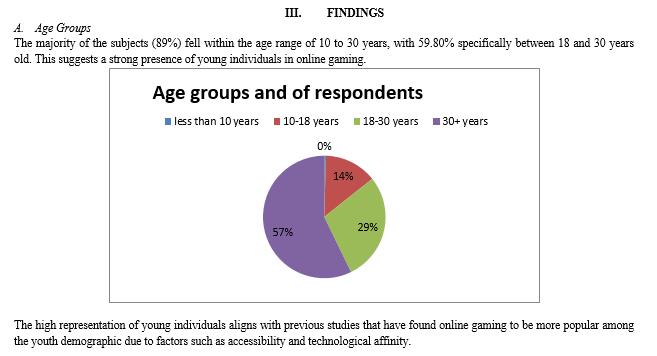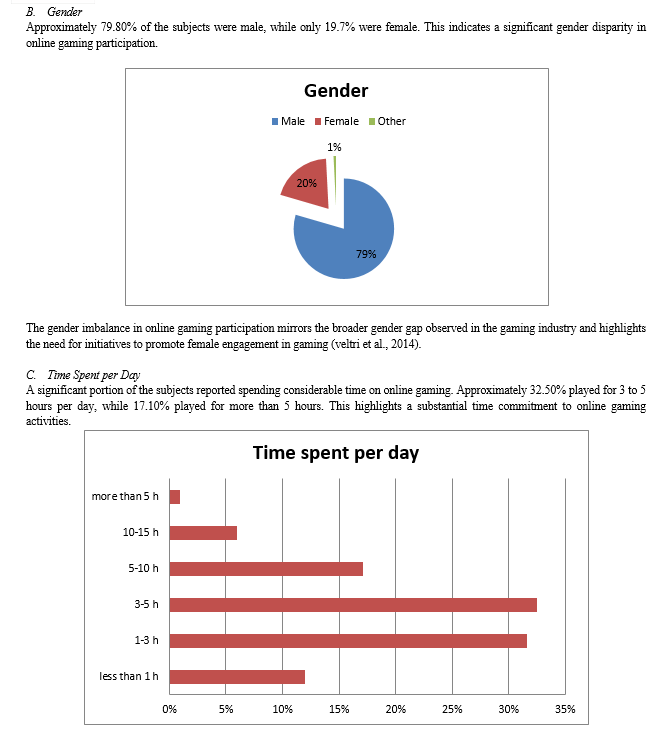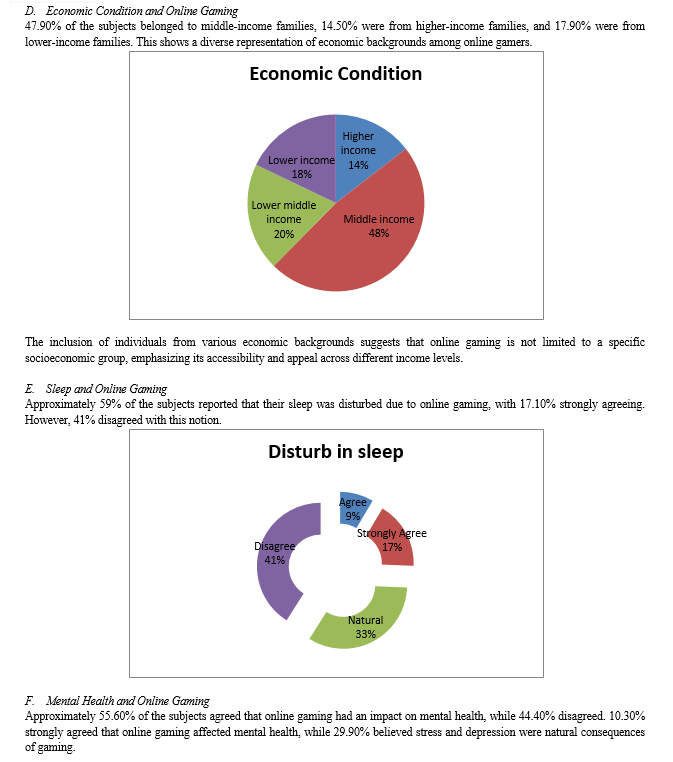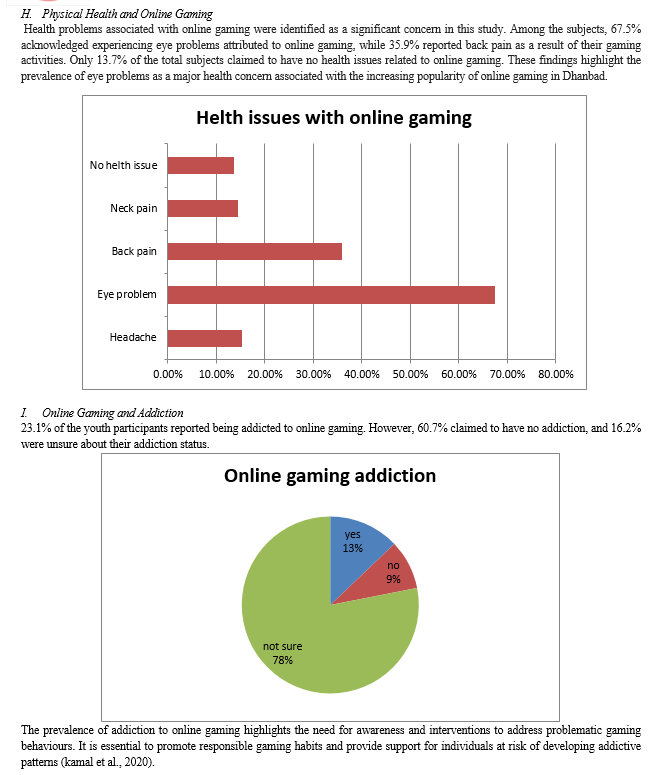Ijraset Journal For Research in Applied Science and Engineering Technology
- Home / Ijraset
- On This Page
- Abstract
- Introduction
- Conclusion
- References
- Copyright
Exploring the Impact and Concerns of Online Gaming: A Survey-Based Study of Dhanbad, India
Authors: Gaurav Kumar Shandilya
DOI Link: https://doi.org/10.22214/ijraset.2023.54712
Certificate: View Certificate
Abstract
This research paper explores the impact and concerns of online gaming, focusing on a survey based study conducted in Dhanbad, India. Online gaming has become a global phenomenon, captivating a diverse range of players and revolutionizing the entertainment industry. However, with its widespread popularity, various concerns have emerged regarding economic risks, online bullying, health issues, and ethical implications. The study conducted in Dhanbad provides insights into the involvement and addiction of the youth population in online gaming, along with the gender division within these communities. The findings highlight the economic opportunities associated with online gaming, as well as the prevalent health concerns such as eye problems. The paper concludes that online gaming offers both entertainment and earning potential, but responsible gaming habits and prioritizing well-being are crucial to maximize its benefits and minimize risks.
Introduction
I. INTRODUCTION
Online gaming has emerged as a global phenomenon, captivating millions of players worldwide and transforming the landscape of entertainment, earning potential, and excitement. With its ever-expanding scope, online gaming has revolutionized video game culture, attracting players of diverse ages, nationalities, and occupations (Yee, 2006). These immersive games create virtual societies that not only entertain but also serve as a fertile ground for various scientific research endeavors (Steinkuehler & Duncan, 2008).
The roots of online gaming can be traced back to the 1970s when computer networking laid the foundation for its inception (Dibbell, 2017). In modern times, advancements in computer networking and internet speed have propelled the widespread adoption of online gaming. Initially, these games began as single-player experiences, but the advent of multiplayer modes enabled the creation of intricate virtual worlds. The integration of high-quality graphics, realistic sound effects, and the emergence of virtual reality (VR) tools further enhanced the immersive experience (Niemeyer & Gerber, 2020).
Economically, the online gaming market has become a lucrative industry, with a global worth of approximately 15 billion dollars (Newzoo, 2022). Leading countries such as China, the United States, and South Korea dominate the market, capturing 70% of its share (Newzoo, 2022). Moreover, online gaming has now gained recognition as a potential career path, with the emergence of numerous online gaming tournaments, including multi-country competitions, emphasizing its future significance (Hamari, Sjöblom, & Ukkonen, 2016).
However, the rapid growth of online gaming has also raised several concerns among organizations and individuals. This research paper aims to delve into these concerns and shed light on their implications. The following areas of concern will be explored:
- Economic Concerns: Debates regarding the skill-based versus luck-based nature of online games often raise concerns about financial risks, particularly when money is involved. Platforms hosting games such as Ludo, categorized as games of luck, further amplify these concerns (Castronova, 2021).
- Online Bullying: With the accessibility of multiplayer online games to players of all ages, the prevalence of online bullying has become a serious concern, especially for minors. Instances such as the 2017 Blue Whale challenge, which led to suicides among youths and minors, highlight the gravity of the issue. Government agencies are actively involved in identifying and banning such games, while data security issues also persist (Livingstone & Smith, 2014).
- Health Issues: Online gaming impacts both mental and physical health. Mentally, online gaming has been associated with stress and depression among youth (Scharkow et al., 2020). Physically, issues like eye strain, headaches, and back pain are common, necessitating attention and awareness of these health concerns (Salguero & Moran, 2002).
- Ethical Concerns: The prevalence of violent activities in many online games has raised moral concerns, particularly regarding the impact on the cognitive development and thought processes of children and youth (Anderson et al., 2010). NGOs and organizations have voiced serious questions regarding the ethical implications of such games (Gentile et al., 2011).
In the midst of these concerns, Dhanbad, known as the coal capital of India, stands as an important study. Dhanbad, situated in the eastern part of India, houses a large tribal population, scheduled castes, and other backward class communities. Despite its significant coal mining industry and large-scale industrial establishments, poverty remains prevalent among a substantial portion of its population. Furthermore, the city has witnessed the impact of the information technology revolution, which is reflected in the increasing popularity of online gaming among the youth.
Therefore, this research project aims to study the involvement and addiction of Dhanbad's youth in online gaming. Additionally, it seeks to explore the reach of online games and gaming culture in small cities and rural areas, focusing on the gender division within these communities. By examining the specific case of Dhanbad, this study will contribute to a comprehensive understanding of the impact and concerns surrounding online gaming in both urban and rural contexts.
II. RESEARCH METHODOLOGY
- Research Design: This study is a descriptive research design to examine the impact and concerns of online gaming in Dhanbad, India. A cross-sectional approach was used to gather data at a specific point in time, providing insights into the current status of online gaming among the youth population.
- Data Collection: The primary data for this study was collected through a structured questionnaire administered via a Google Form survey. The survey consisted of multiple-choice and open-ended questions designed to gather information about the involvement and addiction of youth in online gaming, as well as their perceptions and experiences related to the identified concerns. To identify suitable respondents, various social media groups such as WhatsApp, Facebook, Telegram, and direct meetings with youths of Dhanbad were utilized. These platforms and face-to-face interactions allowed for the identification of individuals who actively engaged in online gaming and were willing to participate in the study.
- Sample Size and Selection: Due to the scope and limitations of the study, a relatively small sample size of 117 subject entries was collected. The sample comprised individuals from Dhanbad who were involved in online gaming. The selection of participants was based on their availability and willingness to participate in the survey.
- Data Analysis: The collected data was subjected to quantitative and qualitative analysis. Quantitative analysis involved the use of statistical tools to examine the frequencies, percentages, and correlations of responses. Qualitative analysis involved interpretation of open-ended responses to gain deeper insights into participants' experiences and perspectives.





IV. SUGGESTIONS
- Initiating awareness programs and counselling sessions, led by the government, social organizations, and schools, can help educate minors and youth about the potential risks of online gaming addiction. Similar counselling services should be made available for all age groups to promote responsible gaming habits.
- Establishing regulating authorities for online gaming apps would enable the censure of unethical gaming content specifically targeted at youth and minors, ensuring that they are protected from harmful influences.
- Encouraging youth to engage in physics-based games can promote physical activity and a healthy lifestyle while still enjoying the gaming experience.
- Implementing a designated "zero electronic device" time period of 2-3 hours per day, where individuals refrain from using electronic devices, especially smart phones, can help reduce excessive screen time and promote offline activities.
- Gaming apps should incorporate features such as time trackers and time limit options to help users monitor and control their gaming duration, promoting moderation and healthy gaming habits.
- Including yoga and meditation as a part of daily routines can help individuals manage gaming-related stress and address addiction concerns by promoting relaxation and mental well-being.
- To mitigate physical health issues associated with online gaming, individuals should take breaks every 30 minutes, use blue light reflection glasses to reduce eye strain, and ensure there is a sufficient gap between continuous levels of the game. Additionally, regular walking breaks should be taken to counteract the effects of continuous sitting.
- Aggressive games should be subject to censorship by government officials to protect individuals from potentially harmful and violent content.
- Online gambling games should be properly regulated to prevent minors from accessing them and engaging in gambling activities.
- To facilitate the growth of online gaming as a legitimate career option, it is crucial to establish proper legal and technical infrastructures that provide a conducive environment for professionals in the field.
- Developing online games specifically designed for elderly individuals can help alleviate problems of loneliness and provide them with engaging social experiences.
V. DELIMITATION OF THE STUDY
It is important to acknowledge the limitations and delimitations of this research. The study's cross-sectional design provided a snapshot of the current status of online gaming but may not have captured the complete dynamics and changes over time. The data collected through Google Form entries relied on the subjects' own views and may have been influenced by biases or subjectivity. Additionally, the sample size of 117 subjects was relatively small, which should be taken into consideration when generalizing the findings.
VI. ACKNOWLEDGMENTS
I would like to acknowledge the participants who took the time to complete the survey and share their experiences.
Conclusion
Online gaming has become a prevalent and popular form of entertainment, not only in India but worldwide. The findings of this study highlight the increasing online gaming culture in small cities like Dhanbad. It is noteworthy that approximately 20% of gamers in these areas are female, indicating a narrowing gender gap in technological participation. However, alongside the growth of online gaming, serious concerns have also emerged. More than 20% of online gamers reported feeling addicted to online gaming, emphasizing the need for awareness and interventions to address problematic gaming behaviours. Additionally, health issues such as eye problems, back pain, and neck pain were prevalent among gamers, with approximately 70% experiencing eye problems. Timely eye checkups for youth are crucial in mitigating these health risks. Online gaming also has the potential to serve as an income source in underdeveloped areas with reliable internet connectivity. In Dhanbad, 27.3% of online gamers reported earning money through online gaming, highlighting the economic opportunities associated with this industry. In conclusion, online gaming offers both entertainment and earning potential, depending on how individuals engage with it. It is important to promote responsible gaming habits, address addiction concerns, and prioritize physical and mental well-being in order to maximize the benefits of online gaming while minimizing its potential risks.
References
[1] Anderson, C. A., Shibuya, A., Ihori, N., Swing, E. L., Bushman, B. J., Sakamoto, A., Saleem, M. (2010). Violent video game effects on aggression, empathy, and prosocial behavior in Eastern and Western countries: A meta-analytic review. Psychological Bulletin, 136(2), 151-173. [2] Castronova, E. (2021). Virtual economies: Design and analysis. Princeton University Press. [3] Dibbell, J. (2017). Play money: Or, how I quit my day job and made millions trading virtual loot. Basic Books. [4] Gentile, D. A., Anderson, C. A., Yukawa, S., Ihori, N., Saleem, M., Ming, L. K.,... Sakamoto, A. (2011). The effects of prosocial video games on prosocial behaviors: International evidence from correlational, longitudinal, and experimental studies. Personality and Social Psychology Bulletin, 37(3), 395-408 [5] Hamari, J., Sjöblom, M., & Ukkonen, A. (2016). The sharing economy: Why people participate in collaborative consumption. Journal of the Association for Information Science and Technology, 67(9), 2047-2059. [6] Livingstone, S., & Smith, P. K. (2014). Annual research review: Harms experienced by child users of online and mobile technologies: The nature, prevalence and management of sexual and aggressive risks in the digital age. Journal of Child Psychology and Psychiatry, 55(6), 635-654. [7] Niemeyer, K., & Gerber, J. (2020). Exploring the potential of virtual reality for video game design: A systematic literature review. Entertainment Computing, 37, 100356. [8] Newzoo. (2022). Global Games Market Report 2022. Retrieved from https://newzoo.com/insights/trend-reports/global-games-market-report/ [9] Salguero, R. A., & Moran, R. (2002). Measuring problem video game playing in adolescents. Addiction, 97(12), 1601-1606. [10] Scharkow, M., Festl, R., Vogelgesang, J., & Quandt, T. (2020). Longitudinal patterns of problematic computer game use among adolescents and adults—a 2-year panel study. Addiction, 115(3), 489-499. [11] Steinkuehler, C., & Duncan, S. (2008). Scientific habits of mind in virtual worlds. Journal of Science Education and Technology, 17(6), 530-543. [12] Yee, N. (2006). The demographics, motivations, and derived experiences of users of massively multi-user online graphical environments. Presence: Teleoperators and Virtual Environments, 15(3), 309-329. [13] Veltri, Natasha & Krasnova, Hanna & Baumann, Annika & Kalayamthanam, Neena. (2014). Gender Differences in Online Gaming: A Literature Review. 20th Americas Conference on Information Systems, AMCIS 2014. [14] Kamal, Nur & Wok, Saodah. (2020). THE IMPACT OF ONLINE GAMING ADDICTION ON MENTAL HEALTH AMONG IIUM STUDENTS. International Journal of Heritage, Art and Multimedia. 3. 01-20. 10.35631/IJHAM.311001.
Copyright
Copyright © 2023 Gaurav Kumar Shandilya. This is an open access article distributed under the Creative Commons Attribution License, which permits unrestricted use, distribution, and reproduction in any medium, provided the original work is properly cited.

Download Paper
Paper Id : IJRASET54712
Publish Date : 2023-07-09
ISSN : 2321-9653
Publisher Name : IJRASET
DOI Link : Click Here
 Submit Paper Online
Submit Paper Online

